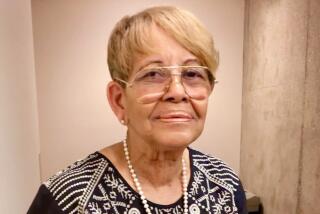Drew Students’ Goal: Help the Poor
A new study finds that the overwhelming majority of Charles R. Drew University students plan to practice medicine in underserved areas upon graduation.
The study, to be published in the September issue of Academic Medicine, was touted by university officials as proof that the oft-criticized institution was succeeding in its mission to bring doctors to the neighborhoods that need them most.
“The thing I find impressive is that in spite of all the turmoil and uncertainty, the bad press and the difficulties, these students are able to look beyond that and say we’ve gotten a fantastic experience,” said Dr. Cornelius Hopper, chairman of the steering committee on the future of Martin Luther King Jr./Drew Medical Center.
When asked if they planned to practice in a socioeconomically underserved area, 86% of Drew students said yes, compared with 20% of UCLA medical students, the study shows.
That commitment by Drew students increased from 68.5% upon matriculation to 86%. The trend at UCLA was the opposite, the study found: beginning at 28.1% and after four years, ending at 20%.
“We already know a minority student who goes to medical school is much more likely to work with minority patients, and students from rural areas go to rural areas,” said Dr. Kevin Grumbach, chairman of the department of family and community medicine at UC San Francisco and one of the study’s authors.
“What’s less clear is, can you take somebody who may or may not be interested in working in South L.A. or East L.A. or the Mission district in San Francisco and give them the type of education and skills that inspires them to work with disadvantaged populations.
“This study says the Drew program works,” he said.
Drew and UCLA established a joint program in 1981 to train students “to provide care with excellence and compassion, especially to underserved populations.”
Twenty-five students spend their first two years at UCLA and their last two at Drew, where they begin their clinical rotations. It enables them to marry the clinical curriculum of UCLA with the social agenda of Drew. For example, each must write a thesis on economic and racial health disparities.
Drew’s medical program is distinct from its residency programs for doctors aspiring to be specialists, which has come under fire by regulators.
As part of the Drew program, students spend a year working in a clinic where they see the same patients and establish relationships.
“You put them with role models and on teams where they can see that taking care of underserved patients, the sickest of the sick and the poorest of the poor,” has rewards, said Dr. Ronald Edelstein, who is acting dean at Charles R. Drew University of Medicine and Science, as well as senior associate dean for academic affairs and a professor of family medicine.
“They feel at the end of their education, that their idealism can continue,” he said.
Michelle Ko, lead author of the study, is a former Drew student and resident in the internal medicine department at David Geffen School of Medicine at UCLA. Her experience at Drew mirrors the findings of the report, she said. Though Ko as an undergraduate leaned toward working in an underserved area, her clinical years at Drew convinced her to do so.
Ko worked for a year at the Imperial Heights Family Health Center, where she came to understand the challenges of serving low-income African Americans and Latinos.
“African American and Latino communities are much more adversely affected by diabetes and hypertension, but also the patients we had tend to be poor and there are issues of safety and violence,” Ko said.
“How do you tell someone to go on a regular exercise program if they don’t feel comfortable walking in their own neighborhood?” Ko said.
The next part of the study, which is in its preliminary stage, will measure whether students follow through on their expressed interest in practicing in underserved areas, Ko said.
More to Read
Sign up for Essential California
The most important California stories and recommendations in your inbox every morning.
You may occasionally receive promotional content from the Los Angeles Times.










